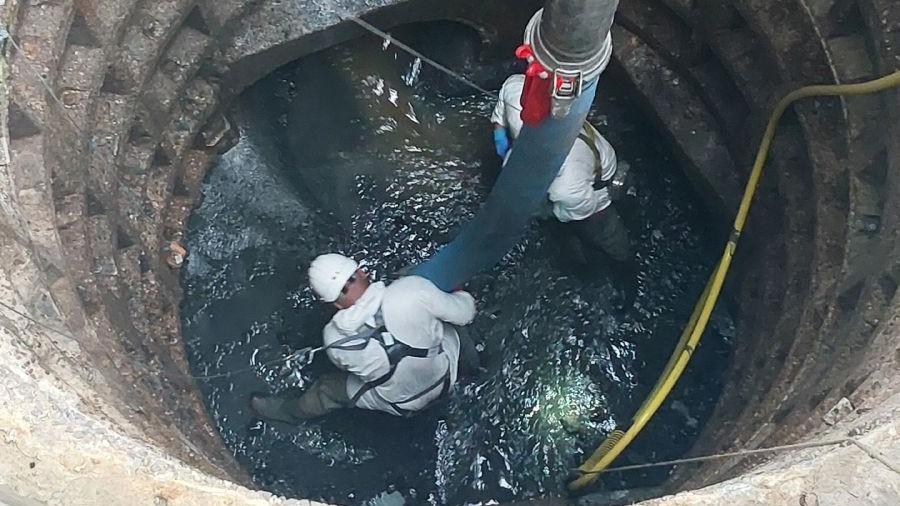Thames Water clears 100-tonne fatberg blocking a London sewer

Thames Water workers remove the fatberg in Feltham
- Thames Water has removed a 100-tonne, 125-metre-long mass of wet wipes congealed in fat, oil and grease from a sewer in Feltham, West London
- Every year the company removes 3.8bn wet wipes that have been flushed, at a cost of £18 million per year
- Blockages caused by wet wipes and other unflushables are the leading cause of pollutions
Thames Water has cleared a 100-tonne fatberg from a sewer in Feltham, which consisted of mainly wet wipes and held together in a solid form by fat, oil and grease.
The blockage was the equivalent of eight double-decker buses and more than ten metres below street-level taking more than a month to remove.
To clear the fatberg access to the sewer from a large manhole chamber measuring three metres in diameter was required by a specialist team equipped with gas monitors for safety. The team blasted, chiselled and sucked the wipes out from along 125-metres of pipe before it was craned into skips and taken to landfill.

The clearance followed the Government’s recent announcement it was introducing legislation to ban wet wipes that contain plastic – a major step towards reducing pollutions. Every year Thames Water clears 75,000 blockages from its sewer network, with wipes as the number one cause, with the company having to remove 3.8 billion each year in operations that cost £18 million.
The company’s “Bin It, Don’t Block It” campaign encourages customers to flush only the three P’s: Pee, Poo, and Paper.
Thames Water actively continues to tackle sewer abuse through several other initiatives, including:
- Installation of 20,000 sewer monitors to enable early detection and clearance of blockages
- Targeted planned maintenance and sewer cleaning in high-blockage hotspot areas
- Ongoing engagement with customers and commercial properties to raise awareness and promote responsible disposal methods.
Alexander Dudfield, Engagement Lead for Network Protection at Thames Water said: “The clearance of this fatberg was hugely complex for our team of engineers and shows some of the challenges we face.
“But while some blockages in our biggest sewers can weigh as much as 25 elephants, we must not forget most blockages occur in local pipes – often narrower than a mobile phone and usually caused by a few households. When these pipes get blocked, we can’t simply switch off the sewage. It backs up and must come out somewhere, whether that’s roads, rivers or even people's homes. The consequences can be devastating.
“We therefore welcome the Government’s move to ban wet wipes containing plastic and will continue to support awareness campaigns like this, which empower people to make small changes that have a big impact on our sewer systems, rivers, and the wider environment.”
As part of Thames Water’s Bin, it, Don’t block it message, it’s important to remember to only flush the three P’s – pee, poo and paper. Flushing away wet wipes, period products or cotton pads can clog pipes, block sewers and pollute rivers and waterways.
Every year Thames Water clears 3.8 billion wipes from its network, which costs £18 million a year.
So far this year Thames Water has cleared
- 28,899 rag blockages, which were primarily made up of wet wipes
- 14,810 fat, oil and grease blockages
- 686 third party blockages, made up of concrete and other sewer blocking materials
Over the next five years Thames Water is targeting a record £9.5 billion (in 2022/23 prices) of investment across its wastewater assets to meet the demands that come with population